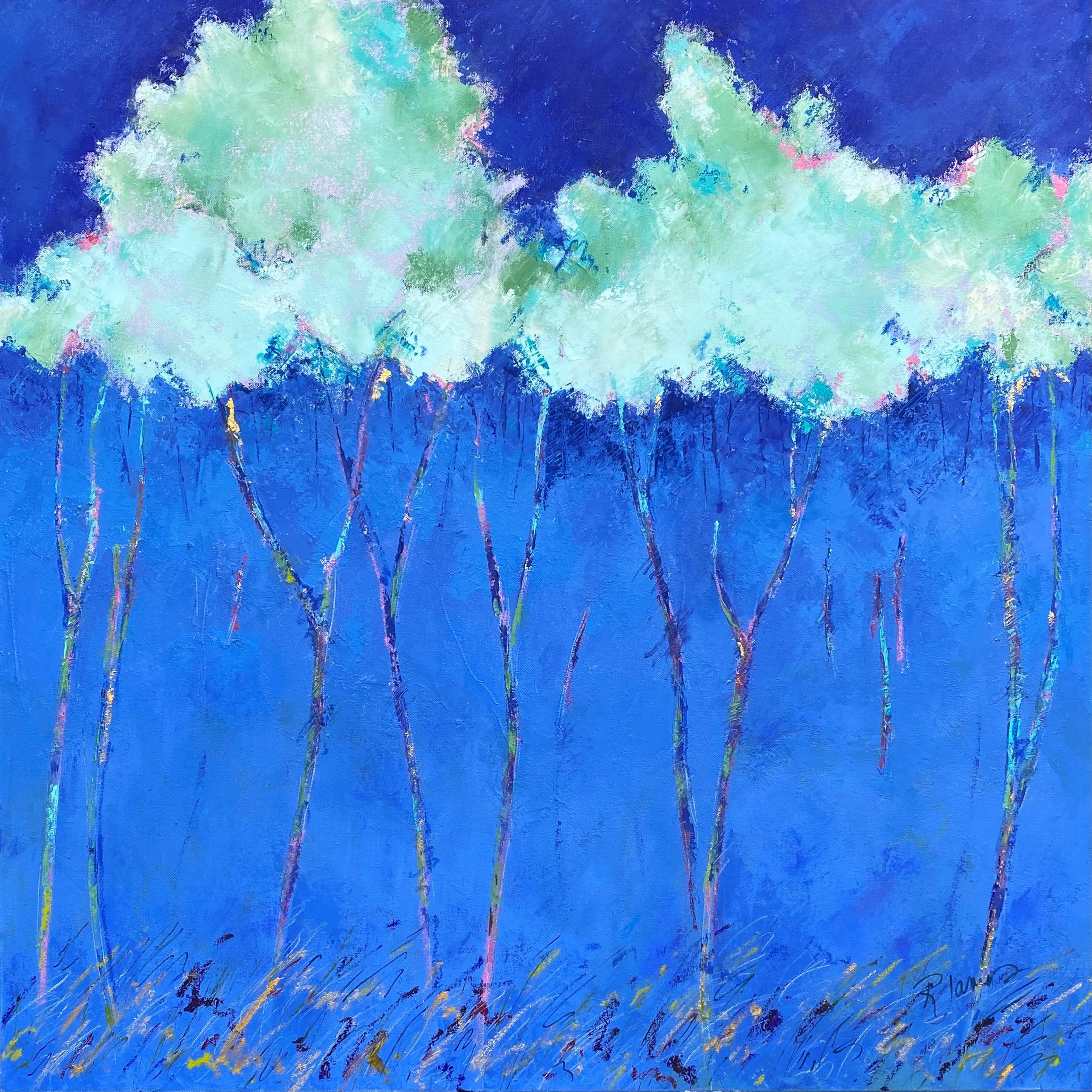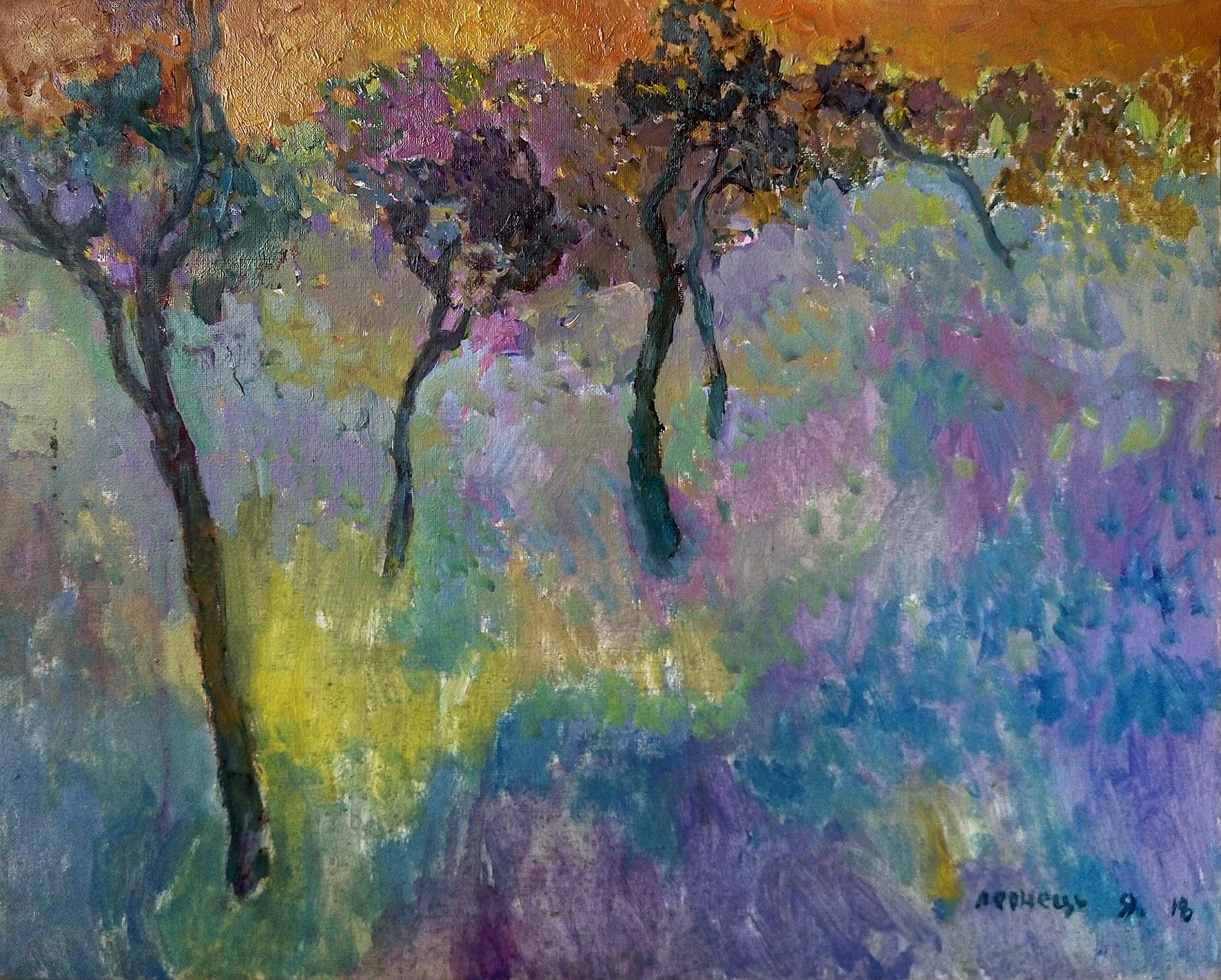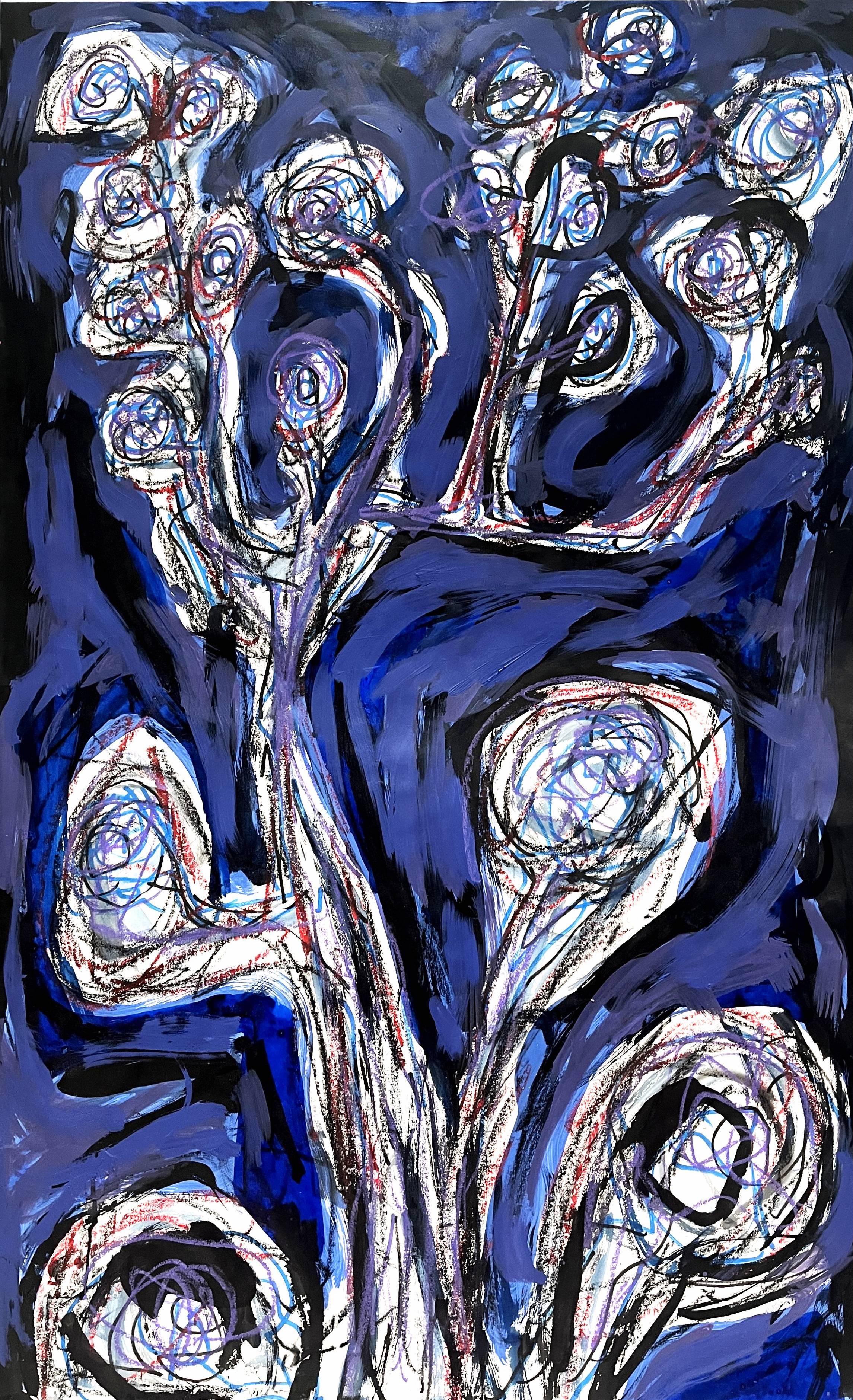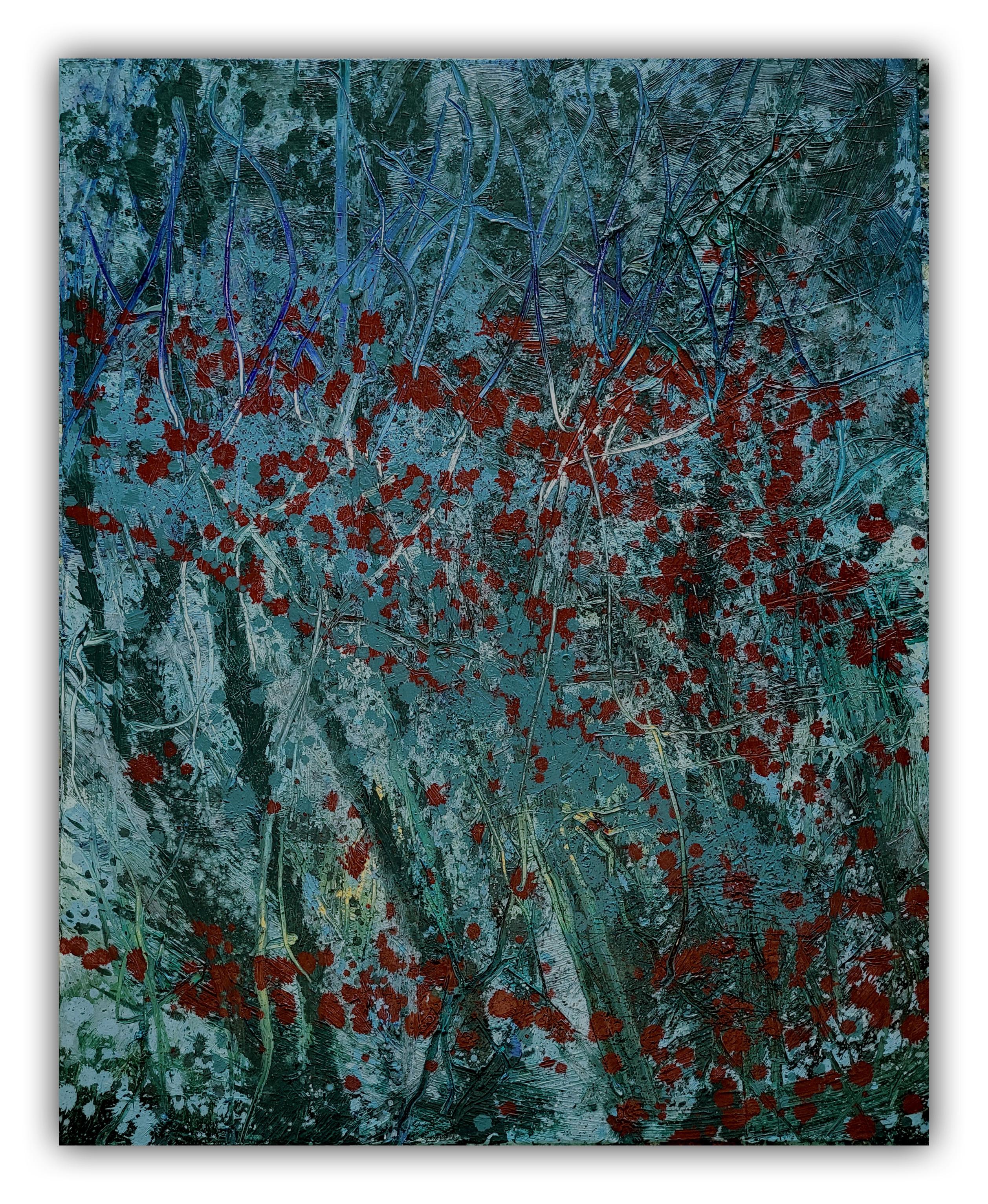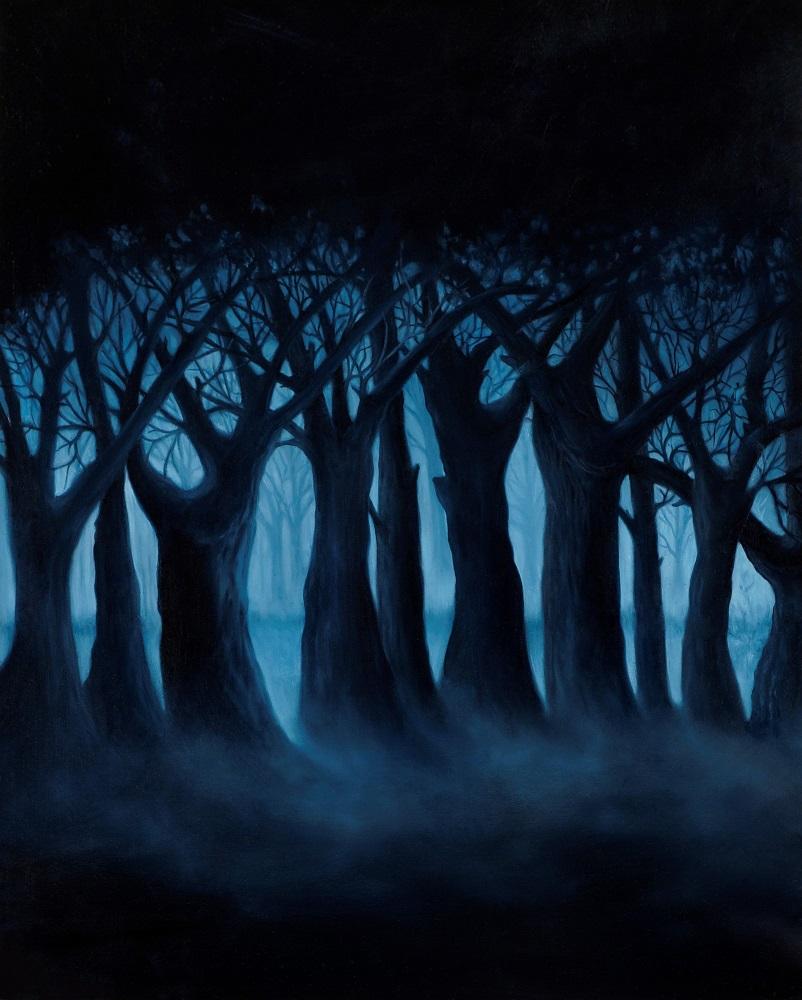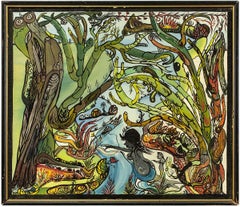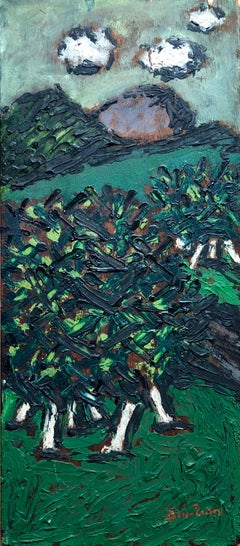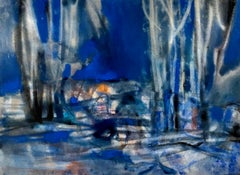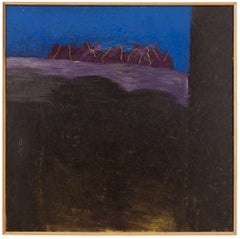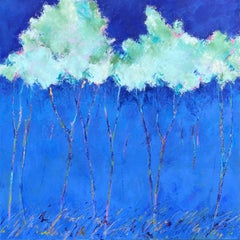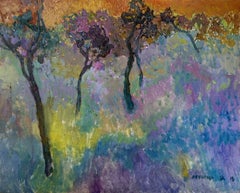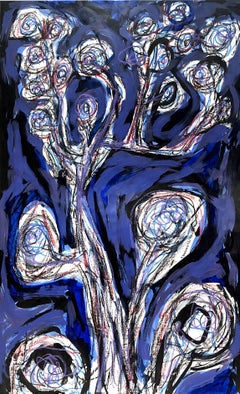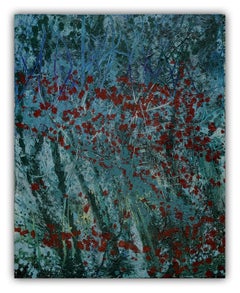Want more images or videos?
Request additional images or videos from the seller
1 of 6
Walter HahnNight Trees1956
1956
$7,500
£5,720.91
€6,517.85
CA$10,541.32
A$11,500.30
CHF 6,089.34
MX$137,806.34
NOK 77,551.11
SEK 70,914.74
DKK 48,667.77
About the Item
Early in the 1950s, WALTER HAHN was a force to be reckoned with in Chicago painting. In 1951, his final year as a student at the School of the Art Institute of Chicago (SAIC), Hahn won first prize in oil in the Chicago and Vicinity exhibition. As this was a purchase prize, this placed his work in the permanent collection of the Art Institute of Chicago, provoking jealous awe from some of his teachers. Born in 1927, Hahn studied with Kathleen Blackshear and Paul Wieghardt and he was a colleague of Leon Golub, who attended SAIC a year before him. In the early ’50s, Hahn was a central figure in the important Momentum exhibits. Mies Van Der Rohe expressed admiration for FEEDING TIME, his contribution to the 1950 Momentum show, and Golub used the back of Hahn’s extremely unusual painting AQUARIUM, which was shown at Momentum in 1951, as a note-pad on which he scrawled suggestions for potential jurists for that year’s exhibition.
Hahn’s early canvases and drawings are playful, figural and highly architectural, extrapolating from Paul Klee’s delicate lines and angles, but featuring a distinctly American sensibility that might in places be akin to Golub’s early monsters, Gwathmey’s outlined figures and elsewhere Milton Avery’s unmodulated patches of color. The Klee influence make sense, as his teacher Wieghardt had worked alongside the Swiss painter, though when asked whether Hahn’s work reminded him of Klee, Wieghardt said: “No, this painting looks like a Walter Hahn.” A noteworthy feature of Hahn’s style is his obsessive attention to detail – indeed, in some cases hair is painted strand-by-strand, grass blade-by-blade, a tree leaf-by-leaf. Hahn applied this sensibility to his designs for jewelry, which he and his wife Maude made and sold to augment their income. Hahn mounted solo exhibitions at Hull House, ETC Gallery, and the Chicago Public Library, and participated widely in group exhibitions.
In 1955, Hahn was awarded the Prix-de-Rome. While in Italy, he painted large, often mythologically inspired canvases – Janus-faced faced figures, Medusas, 100-eyed women, winged snakes. Late in the ’50s, Hahn moved to New York, where he was represented by Gallery G, alongside an as-yet-unknown artist named Lee Bontecou. By the mid ’60s, his work had grown somewhat more naturalistic, influenced by a growing immersion in Asian culture, and in 1964 he stopped painting and by-and-large left the public artworld – not unlike Bontecou. Hahn’s creative life has continued through his design of Japanese tea ceremony teaspoons, of which his is one of the very few non-Japanese masters, and in the form of highly personal collages, which he has yet to exhibit. This exhibition at Corbett vs. Dempsey will bring together Walter Hahn’s Chicago-era paintings and drawings for the first time since the 1950s. Among the works exhibited will be sketches of H. C. Westermann, who was a model in life-drawing classes in the late ’40s, and an astonishing group of pieces drawn and painted directly onto the pages of a Swedish book on massage. Hahn’s important canvases on display will include AQUARIUM and SATAN, as well as MEDUSA II, WINGED SNAKES and GOLDEN BOUGH from the prix-de-Rome years.
- Creator:Walter Hahn (1898-1969, German)
- Creation Year:1956
- Dimensions:Height: 48 in (121.92 cm)Width: 75.75 in (192.41 cm)
- Medium:
- Movement & Style:
- Period:
- Condition:Good condition, slight wear on front of the frame.
- Gallery Location:Surfside, FL
- Reference Number:Seller: 13551stDibs: LU38212050912
About the Seller
4.9
Platinum Seller
Premium sellers with a 4.7+ rating and 24-hour response times
Established in 1995
1stDibs seller since 2014
1,845 sales on 1stDibs
Typical response time: 1 hour
- ShippingRetrieving quote...Shipping from: Surfside, FL
- Return Policy
More From This Seller
View AllNaive Abstract Landscape Folk Art
Located in Surfside, FL
Fantasy landscape naive art oil painting, signed, S. Smith, left side of painting.
Category
20th Century Folk Art Landscape Paintings
Materials
Oil, Board
American Modernist Oil Painting Gestural Landscape WPA Artist Group of 10
By Ben-Zion Weinman
Located in Surfside, FL
Born in 1897, Ben-Zion Weinman celebrated his European Jewish heritage in his visual works as a sculptor, painter, and printmaker. Influenced by Spinoza, Knut Hamsun, and Wladyslaw Reymont, as well as Hebrew literature, Ben-Zion wrote poetry and essays that, like his visual work, attempt to reveal the deep “connection between man and the divine, and between man and earth.”
An emigrant from the Ukraine, he came to the US in 1920. He wrote fairy tales and poems in Hebrew under the name Benzion Weinman, but when he began painting he dropped his last name and hyphenated his first, saying an artist needed only one name.
Ben-Zion was a founding member of “The Ten: An Independent Group” The Ten” a 1930’s avant-garde group, Painted on anything handy. Ben-Zion often used cabinet doors...
Category
Mid-20th Century Expressionist Figurative Paintings
Materials
Oil, Wood Panel
Large Modernist Abstract Expressionist Gouache Painting Bauhaus Weimar Artist
By Pawel Kontny
Located in Surfside, FL
Abstract watercolor or gouache composition bearing the influence of the earlier color-block compositions of Paul Klee.
Pawel August Kontny, (Polish-German-American artist) He was born in Laurahuette, Poland, in 1923, the son of a wealthy pastry shop owner. In 1939 he began studying architecture in Breslau where he was introduced to the European masters and to the work of some of the German Expressionists, soon afterward banned as "degenerate artists" and removed from museums throughout Germany by the Nazi regime. His studies were interrupted by World War II. Drafted into the German army, traveling in many countries as a soldier, he sketched various landscapes but in 1945, he was captured and held as a prisoner of war in Italy. After the war, he studied at the Union of Nuremberg Architects to help design buildings to replace ones destroyed in the war. He recorded his impressions of the local population and the landscapes through his watercolors and drawings. Pawel Kontny thereafter moved to Nuremberg, Germany, becoming a member of the Union of Nuremberg Architects and helping to rebuild the city's historic center. He soon decided to concentrate on his professional art career. He married Irmgard Laurer, a dancer with the Nuremberg Opera. Pavel Kontny 's career as an artist was launched with his participation in an all German exhibition, held at the Dusseldorf Museum in 1952. He held one-man shows in Germany, Switzerland and the United States. During his trip to the United States in 1960, Kontny became instantly enamored with Colorado, and decided to relocate to Cherry Hills with his wife and two children. He quickly established himself in the local art community, being affiliated for a time with Denver Art Galleries and Saks Galleries. His subject matter became the Southwest. During this time he received the Prestigious Gold Medal of the Art Academy of Rome. His extensive travel provided material for the paintings he did using his hallmark marble dust technique. he also worked equally in pastel, watercolor, charcoal and pencil-and-ink. in a style which merged abstraction and realist styles, influenced by Abstract Expressionist painting and South Western American landscapes. In the early 1960s he was one of only a few European-born professional artists in the state, a select group that included Herbert Bayer (1900-1985), a member of the prewar Bauhaus in Weimar and Dessau, Germany, and Roland Detre...
Category
20th Century American Modern Landscape Paintings
Materials
Watercolor, Archival Paper
Large Israel Modernist Landscape Painting Bezalel Artist
By Larry Abramson
Located in Surfside, FL
In this painting the artist Larry Abramson depicts an abstract landscape with a high degree of simplification, taking references from the stylistic conventions of conceptual and mini...
Category
20th Century Modern Abstract Paintings
Materials
Wood, Acrylic
Large German Neo Figuarist Abstract Expressionist Oil Painting Werner Liebmann
Located in Surfside, FL
WERNER LIEBMANN (German b. 1951)
"Elf Köpfe Bei Nacht,"
Oil on canvas, signed L/R, "Liebmann;"
29 1/4'' x 35 1/2'', framed 31'' x 37''.
Werner Liebmann (born 1951) is a German painter and graphic artist .
Werner Liebmann was born in Königsthal in Thuringia. Born in Königsthal from 1969 to 1973 he studied chemistry at the Martin Luther University in Halle (Saale) . From 1973 to 1976 he worked as a project engineer. He was active as a chemist until he opted for an artistic career and studied painting at the University of Art and Design in Halle. A master student of Bernhard Heisig, he graduated at the College of Fine Arts Leipzig.
Since then, he has been a freelance artist, as well as a professor at the College of Fine Arts in Dresden and currently at the Art school Berlin – Weissensee. His works were represented at numerous group exhibitions and solo exhibitions in Halle, Hamburg, Berlin, Düsseldorf and further cities, mostly in Germany. Influenced by the Neo Figuraist artists of the Junge Wilde painters. In 1978, the Junge Wilde painting style arose in the German-speaking world in
opposition to established avant garde, minimal art and conceptual art. It was linked to the similar Transavanguardia movement in Italy, USA (neo-expressionism) and France (Figuration Libre). The Junge Wilde painted their expressive paintings in bright, intense colors and with quick, broad brushstrokes very much influenced by Professor at the Academy of Art in Berlin, Karl Horst Hödicke (b:1938). They were sometimes called the Neue Wilde. Berlin: Luciano Castelli...
Category
Late 20th Century Neo-Expressionist Abstract Paintings
Materials
Canvas, Oil
Mil Lubroth Mixed Media Oil Painting Contemporary Female Abstract Expressionist
By Mil Lubroth
Located in Surfside, FL
Mil Lubroth lived in New York, France,
Oil on board
Abstract expressionist Tree's in greens and purples
Provenance: Gallery Bique, Madrid. bears label verso
Dimensions: Frame Siz...
Category
Mid-20th Century Conceptual Abstract Paintings
Materials
Mixed Media, Oil
You May Also Like
Blue -Night Trees 36 X 36
Located in West Palm Beach, FL
Night Trees 36 X 36 Oil on Canvas
Rose James considers herself as a botanical abstractionist. Her inspiration comes from years as a botanical artist teaching for the New York Botani...
Category
2010s Naturalistic Landscape Paintings
Materials
Canvas, Oil
$2,250 Sale Price
25% Off
"Trees"
Located in Edinburgh, GB
LANDSCAPE SERIES
Everyone knows that a coin has two sides. One depicts an heads, and other tails. The two sides are different, but they are folded into one indivisible coin. So is ma...
Category
21st Century and Contemporary Abstract Landscape Paintings
Materials
Canvas, Oil
Tree 2
By Renelio Marin
Located in New York, NY
Renelio Marin
Tree Series, 2018
40 x 25 in
Acrylic Painting
Renelio Marin is a visual artist with a diverse range of influences and styles and the co-owner of AMRM Gallery. Born in ...
Category
2010s Abstract Abstract Paintings
Materials
Paper, Pastel, Acrylic, Color Pencil
Nightplants (Abstract Painting)
Located in London, GB
Reiner Heidorn is a self-taught German contemporary painter known for monumental abstract oil paintings that dissolve the boundaries between humanity and nature. Working from his stu...
Category
2010s Abstract Abstract Paintings
Materials
Canvas, Oil
Trees 21 October 09:49 - Modern Nature Painting, Landscape, Forest, Contemplativ
By Robert Motelski
Located in Salzburg, AT
Robert Motelski's paintings are exceptional visions of nature, visions of space which surrounds us. They tell about being, fate and passing. They depend on the season of year, the ti...
Category
2010s Contemporary Landscape Paintings
Materials
Canvas, Oil
Ancestral Trees
Located in Boston, MA
Artist Commentary:
This image is drawn from my imagination and imagery that I am inspired by.
Keywords: Landscape
Artist Biography:
Judith grew up 15 miles north of Milwaukee in t...
Category
21st Century and Contemporary Naturalistic Landscape Paintings
Materials
Oil, Panel
More Ways To Browse
Modern Tree Painting
Unusual Paintings
Oil Paintings By C Walters
Japanese Tea Ceremony
Lee Bontecou
H C Westermann
Expressionist Impasto
Metallic Abstract Art
Red Crayon
Art Striped Paintings
Louise Nevelson Creating A Sculpture
Maui Art
Shizico Yi
Abstract Realism Paintings
Bed Painting
Explosion Art
Bronx Art
Heaven Paintings
